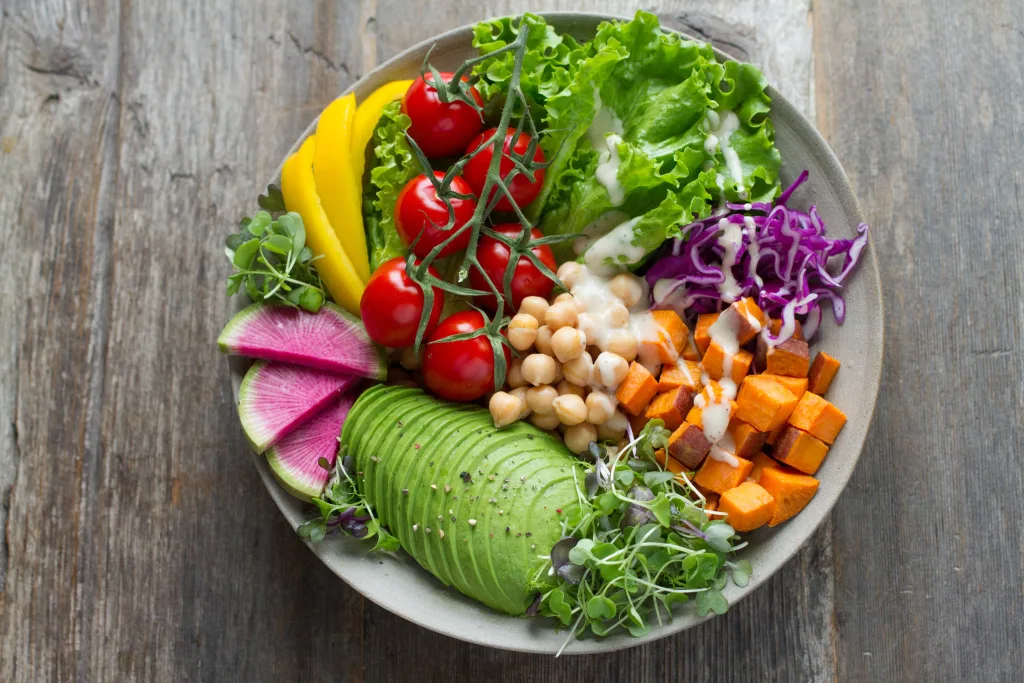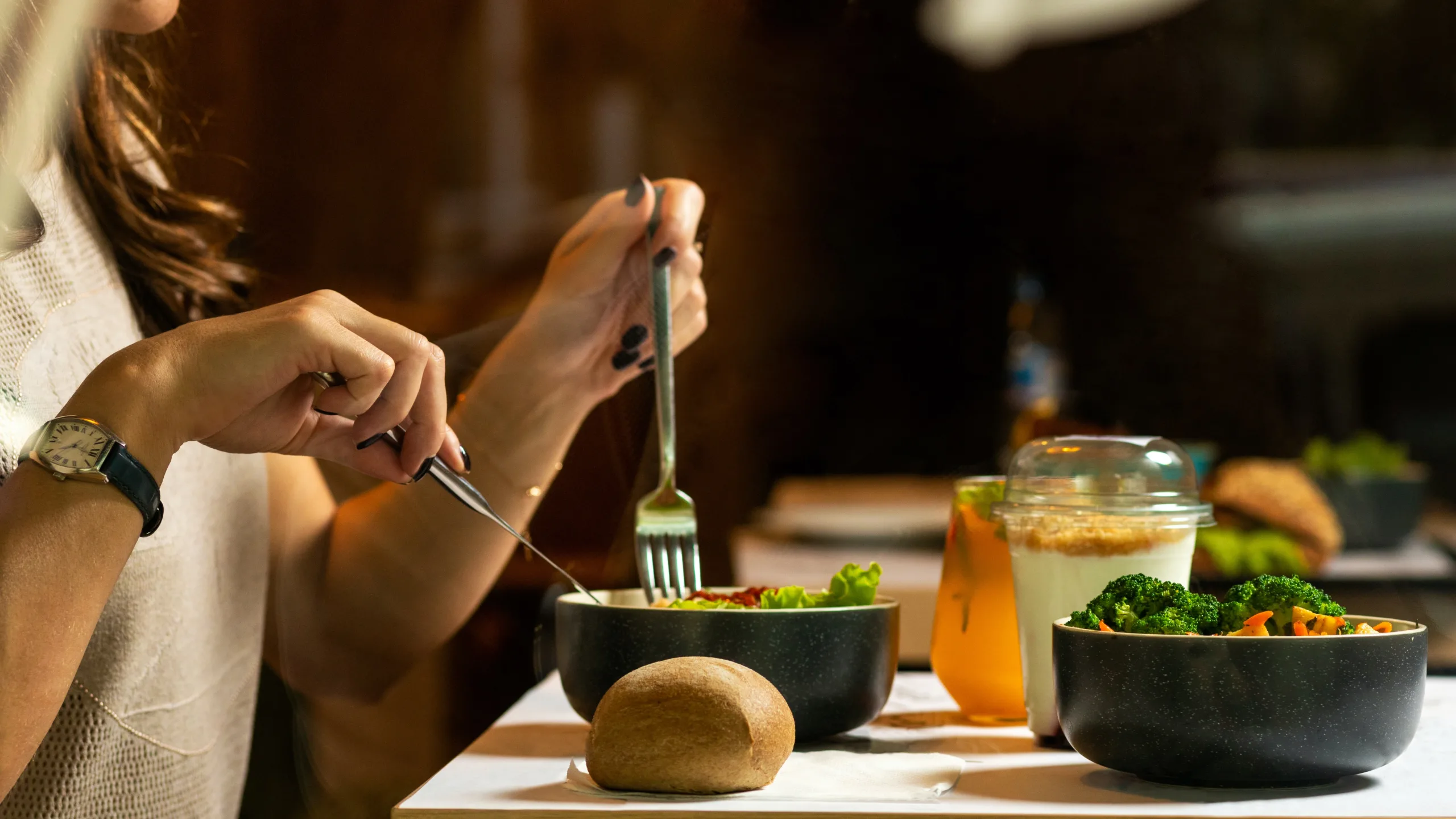Let’s dive into the DASH eating plan that provides a balanced diet of 1,800 to 2,000 calories per day. This plan is recommended by the National Heart, Lung, and Blood Institute and has been scientifically proven to lower blood pressure and provide other health benefits1.
The DASH eating plan is divided into several food groups, each with a recommended number of servings per day. Let’s explore each group and how they contribute to a balanced diet.
Grains (6-8 servings per day): Grains, especially whole grains, are a good source of fiber and magnesium. A serving could be a slice of bread, an ounce of dry cereal, or half a cup of cooked rice, pasta, or cereal. Examples include oatmeal, grits, brown rice, unsalted pretzels, popcorn, whole grain cereal, whole wheat bread, rolls, pasta, English muffin, pita bread, and bagel1.
Vegetables (4-5 servings per day): Vegetables provide potassium, magnesium, and fiber. A serving is a cup of raw leafy vegetables, half a cup of cut-up raw or cooked vegetables, or half a cup of vegetable juice. Examples include broccoli, carrots, collards, green beans, green peas, kale, lima beans, potatoes, spinach, squash, sweet potatoes, and tomatoes1.
Fruits (4-5 servings per day): Fruits are also a good source of potassium, magnesium, and fiber. A serving is a medium fruit, a quarter cup of dried fruit, or half a cup of fresh, frozen, or canned fruit, or fruit juice. Examples include apples, apricots, bananas, dates, grapes, oranges, grapefruit, grapefruit juice, mangoes, melons, peaches, pineapples, raisins, strawberries, and tangerines1.
Dairy (2-3 servings per day): Dairy products provide calcium and protein. A serving is a cup of milk or yogurt, or one and a half ounces of cheese. Examples include fat-free (skim) or low-fat (1%) milk or buttermilk; fat-free, low-fat, or reduced-fat cheese; fat-free or low-fat regular or frozen yogurt; fortified soy beverage; and lactose-free products1.
Lean Meats, Fish, Poultry, and Eggs (6 servings or less per day): These are sources of protein and magnesium. A serving is an ounce of cooked meats, fish, or poultry, or one egg. Examples include chicken or turkey without skin; salmon, tuna, trout; and lean cuts of beef, pork, and lamb1.
Fats and Oils (2-3 servings per day): These provide energy and vitamin E. A serving is a teaspoon of soft margarine or vegetable oil, a tablespoon of mayonnaise, or two tablespoons of salad dressing. Examples include soft margarine, vegetable oil (such as canola, corn, olive, or safflower), low-fat mayonnaise, and light salad dressing1.
Nuts, Seeds, and Legumes (4-5 servings per week): These are sources of energy, magnesium, protein, and fiber. A serving is a third of a cup or one and a half ounces of unsalted nuts, two tablespoons of peanut butter, two tablespoons or half an ounce of seeds, or half a cup of cooked legumes (dry beans and peas). Examples include almonds, hazelnuts, mixed nuts, peanuts, walnuts, sunflower seeds, peanut butter, kidney beans, lentils, and split peas1.
Sweetsand Added Sugars (5 servings or less per week): Sweets should be low in fat. A serving is a tablespoon of sugar or jelly or jam, half a cup of sorbet or gelatin, or a cup of lemonade. Examples include fruit-flavored gelatin, fruit punch, hard candy, jelly, maple syrup, sorbet, and ices, and sugar1.
Now, let’s look at a sample meal plan for a day:
Breakfast: Start your day with a bowl of oatmeal (1 serving of grains) topped with a medium banana (1 serving of fruits) and a handful of almonds (1 serving of nuts, seeds, and legumes). Pair it with a cup of low-fat milk (1 serving of dairy). This meal provides a balanced intake of grains, fruits, dairy, and nuts.
Lunch: For lunch, have a turkey sandwich with two slices of whole wheat bread (2 servings of grains), lean turkey slices (1 serving of lean meats), and a slice of low-fat cheese (1 serving of dairy). Add a side salad of raw leafy vegetables (1 serving of vegetables) and a medium apple for dessert (1 serving of fruits).
Dinner: A dinner could be a piece of grilled salmon (1 serving of lean meats), a side of brown rice (2 servings of grains), steamed broccoli (1 serving of vegetables), and a cup of fresh, mixed berries (1 serving of fruits).
Snack: For a snack, you could have a cup of low-fat yogurt (1 serving of dairy) with a quarter cup of unsweetened dried fruit (1 serving of fruits).
Remember, the DASH eating plan is flexible and can be adjusted based on your specific calorie needs. Always consult with a healthcare provider or a registered dietitian for personalized advice.

6-DAY DASH Diet Example:
Day 1:
- Lunch: Grilled chicken salad (170g chicken, ~330 calories), two slices of whole grain bread (56g, ~140 calories), and two pieces of fresh fruit (300g, ~120 calories). Total: ~590 calories
- Dinner: Baked salmon (170g, ~412 calories), a side of steamed broccoli (156g, ~52 calories), brown rice (250g cooked, ~432 calories), and a mixed fruit salad (300g, ~120 calories). Total: ~1016 calories
Day 2:
- Lunch: Tuna salad sandwich on whole grain bread (112g bread, ~280 calories; 170g tuna, ~200 calories), carrot and celery sticks (200g, ~80 calories), and two apples (300g, ~160 calories). Total: ~720 calories
- Dinner: Grilled lean steak (170g, ~500 calories), sweet potato (260g, ~224 calories), green beans (156g, ~62 calories), and a cup of mixed berries (300g, ~120 calories). Total: ~906 calories
Day 3:
- Lunch: Vegetable stir-fry with tofu (170g tofu, ~288 calories; 400g vegetables, ~200 calories) served over brown rice (250g cooked, ~432 calories), and two bananas (240g, ~210 calories). Total: ~1130 calories
- Dinner: Baked chicken (170g, ~330 calories), quinoa (370g cooked, ~440 calories), steamed carrots (156g, ~64 calories), and a peach (150g, ~59 calories). Total: ~893 calories
Day 4:
- Lunch: Turkey and cheese sandwich on whole grain bread (112g bread, ~280 calories; 170g turkey, ~270 calories; 80g cheese, ~320 calories), a side salad (170g, ~30 calories), and two pears (300g, ~204 calories). Total: ~1104 calories
- Dinner: Grilled fish (170g, ~400 calories), whole grain pasta (280g cooked, ~400 calories) with olive oil (28g, ~240 calories) and garlic (6g, ~10 calories), steamed spinach (170g, ~40 calories), and a cup of pineapple (330g, ~164 calories). Total: ~1254 calories
Day 5:
- Lunch: Vegetable soup (500g, ~300 calories), two slices of whole grain bread (56g, ~140 calories), and a cup of grapes (300g, ~104 calories). Total: ~544 calories
- Dinner: Baked lean pork (170g, ~504 calories), sweet potato (260g, ~224 calories), steamed asparagus (180g, ~40 calories), and a cup of mixed fruit (300g, ~120 calories). Total: ~888 calories
Day 6:
- Lunch: Chicken Caesar salad with light dressing (170g chicken, ~330 calories; 170g salad, ~30 calories), two slices of whole grain bread (56g, ~140 calories), and two oranges (300g, ~124 calories). Total: ~624 calories
- Dinner: Shrimp stir-fry with a variety of vegetables (170g shrimp, ~170 calories; 400g vegetables, ~200 calories) served over brown rice (250g cooked, ~432 calories), and a cup of strawberries (300g, ~98 calories). Total: ~900 calories
Remember, the DASH eating plan also recommends 4-5 servings of nuts, seeds, and legumes per week (1 serving = 28g nuts/seeds, ~170 calories; 85g cooked legumes, ~100 calories), and 5 or fewer servings of sweets and added sugars per week (1 serving = 14g sugar, ~56 calories). You can incorporate these into your meals or have them as snacks. Also, remember to drink plenty of water and limit your sodium intake to 1,500-2,300 milligrams per day.
References:

